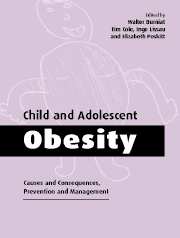Book contents
- Frontmatter
- Contents
- List of contributors
- Foreword
- Preface
- Part I Causes
- 1 Measurement and definition
- 2 Epidemiology
- 3 Molecular and biological factors with emphasis on adipose tissue development
- 4 Nutrition
- 5 Physical Activity
- 6 Psychosocial factors
- Part II Consequences
- Part III Prevention and management
- Index
2 - Epidemiology
Published online by Cambridge University Press: 02 November 2009
- Frontmatter
- Contents
- List of contributors
- Foreword
- Preface
- Part I Causes
- 1 Measurement and definition
- 2 Epidemiology
- 3 Molecular and biological factors with emphasis on adipose tissue development
- 4 Nutrition
- 5 Physical Activity
- 6 Psychosocial factors
- Part II Consequences
- Part III Prevention and management
- Index
Summary
Introduction
The epidemiology of obesity is concerned with the frequency, distribution and determinants of obesity in populations. Although it includes studies of the association of obesity in childhood with obesity in adult life, with heart disease and diabetes, and with the prevention of obesity, these aspects of epidemiology are discussed extensively in Chapters 6, 8 and 12 and are not discussed further here.
Epidemiological data aid understanding of the complex natural history of obesity in childhood and adolescence, providing information on general patterns of obesity, geographic, ethnic and social class differences and differences in prevalence over time. Epidemiological studies may help predict the likelihood of obesity persisting into adulthood and the consequent risks for morbidity and mortality. Populations at high risk of obesity can then be identified – something which could be of major interest in the development of prevention programmes.
This chapter discusses the current prevalence of obesity world-wide; how fatness is associated with ethnicity, socioeconomic group, and school performance; what can be learnt from trends in obesity over time and across geographic areas; and whether it is possible to identify groups at higher risk of obesity or at risk of persistent obesity.
Epidemiology and methods
Definition
The advantages and disadvantages of relative body mass index (BMI) for the diagnosis of overweight and obesity and the choices for reference populations and cut-off points have been reviewed in Chapter 1.
- Type
- Chapter
- Information
- Child and Adolescent ObesityCauses and Consequences, Prevention and Management, pp. 28 - 49Publisher: Cambridge University PressPrint publication year: 2002
- 14
- Cited by



